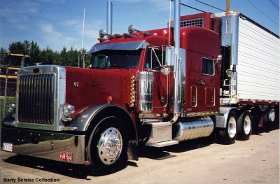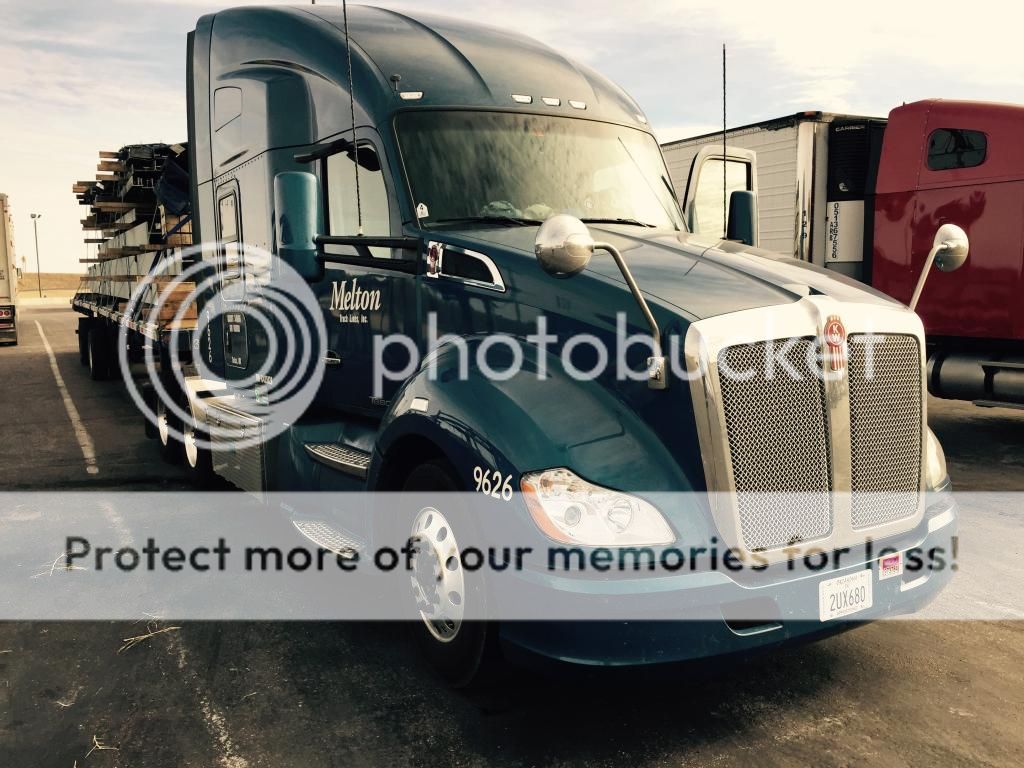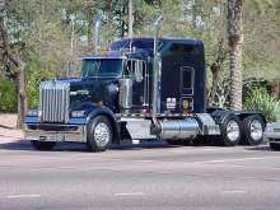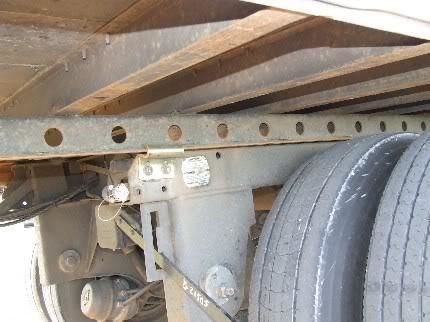Rookies, What Would You Do?
Topic 5345 | Page 1

Alright. Ill take a stab at this. Since you cant move the tandems any further back and you still have 3k of room on your drives. I would try sliding the fifth wheel. Also, is the load in the trailer balanced or piled up in the back.
Tandems:
Tandem Axles
A set of axles spaced close together, legally defined as more than 40 and less than 96 inches apart by the USDOT. Drivers tend to refer to the tandem axles on their trailer as just "tandems". You might hear a driver say, "I'm 400 pounds overweight on my tandems", referring to his trailer tandems, not his tractor tandems. Tractor tandems are generally just referred to as "drives" which is short for "drive axles".
Tandem:
Tandem Axles
A set of axles spaced close together, legally defined as more than 40 and less than 96 inches apart by the USDOT. Drivers tend to refer to the tandem axles on their trailer as just "tandems". You might hear a driver say, "I'm 400 pounds overweight on my tandems", referring to his trailer tandems, not his tractor tandems. Tractor tandems are generally just referred to as "drives" which is short for "drive axles".
Alright. Ill take a stab at this. Since you cant move the tandems any further back and you still have 3k of room on your drives. I would try sliding the fifth wheel. Also, is the load in the trailer balanced or piled up in the back.
Okay, good suggestion. We'll touch base on that point later.
You have no idea how the interior of the trailer looks. It's a preloaded trailer and shipper won't allow you to break the seal just to have a look. So to answer your question, you don't know.
Shipper:
The customer who is shipping the freight. This is where the driver will pick up a load and then deliver it to the receiver or consignee.
Tandems:
Tandem Axles
A set of axles spaced close together, legally defined as more than 40 and less than 96 inches apart by the USDOT. Drivers tend to refer to the tandem axles on their trailer as just "tandems". You might hear a driver say, "I'm 400 pounds overweight on my tandems", referring to his trailer tandems, not his tractor tandems. Tractor tandems are generally just referred to as "drives" which is short for "drive axles".
Tandem:
Tandem Axles
A set of axles spaced close together, legally defined as more than 40 and less than 96 inches apart by the USDOT. Drivers tend to refer to the tandem axles on their trailer as just "tandems". You might hear a driver say, "I'm 400 pounds overweight on my tandems", referring to his trailer tandems, not his tractor tandems. Tractor tandems are generally just referred to as "drives" which is short for "drive axles".

Call my dispatcher and let them know about the problem. I wont drive illegally until someone comes and takes some of the load out of my truck. My license is on the line and I know a company wont back me up for something like this if I get a ticket. If they don't like it then I'll go find a new company to work for that will respect my license and legal driving.
Least that's what the college trucking course is telling me to do when we touched base on this a week or so ago.
I don't even have a job yet. So thats just my two cents!
Dispatcher:
Dispatcher, Fleet Manager, Driver Manager
The primary person a driver communicates with at his/her company. A dispatcher can play many roles, depending on the company's structure. Dispatchers may assign freight, file requests for home time, relay messages between the driver and management, inform customer service of any delays, change appointment times, and report information to the load planners.
Hmmm. I figured you would say something like that. Yea, im going with sliding the fifth wheel and see what that gets me.

Well I might be wrong but thats how you learn so here we go if your on the12 hole and your overweight I think that means the whole truck is overweight. I have heard a gallon of water is seven pounds so fuel may be close to that I would plan my stops so I had about7 gallons less that would be 49 pounds off until I got to a state where I was legal to top off with fuel " keeping in mind I have to have enough to get threw the state. so that's my stab at it ..I like your idea here great learning tool!

That's why I love this site...keeps my brain fried!
Hmm...I was under the assumption that sliding the fifth wheel redistributed the weight between the drives and the steer..not so much the trailer tandems. So...I'd have to say you either find a way to redistribute the load in the trailer or as you mentioned...you take bend the rules. One question though....I thought it was more of a king pin to axle distance vs. a 12th hole rule.
And btw...I've never even driven one yet so this is a true rookie here...
Tandems:
Tandem Axles
A set of axles spaced close together, legally defined as more than 40 and less than 96 inches apart by the USDOT. Drivers tend to refer to the tandem axles on their trailer as just "tandems". You might hear a driver say, "I'm 400 pounds overweight on my tandems", referring to his trailer tandems, not his tractor tandems. Tractor tandems are generally just referred to as "drives" which is short for "drive axles".
Tandem:
Tandem Axles
A set of axles spaced close together, legally defined as more than 40 and less than 96 inches apart by the USDOT. Drivers tend to refer to the tandem axles on their trailer as just "tandems". You might hear a driver say, "I'm 400 pounds overweight on my tandems", referring to his trailer tandems, not his tractor tandems. Tractor tandems are generally just referred to as "drives" which is short for "drive axles".

Fuel weighs 8 lbs. per gallon. Burn off 5 to 6 gallons of fuel, make a note of where that is on your fuel gauge and keep it under that amount. Now, just how long it takes to idle off 5 gallons of fuel? I don't know. But, the cost of 5-6 gallons of fuel has got to be less than an overweight fine, not to mention possible points on your CSA score.
Just my $.02
Tarren
CSA:
Compliance, Safety, Accountability (CSA)
The CSA is a Federal Motor Carrier Safety Administration (FMCSA) initiative to improve large truck and bus safety and ultimately reduce crashes, injuries, and fatalities that are related to commercial motor vehicle

I'm not much of a forum poster, but I guess this as good a place as any to make myself known on here.
My guess would be that if it is set in the maximum hole already, and still have that much weight difference between the tandems and drives, I would bring it back to the shipper and make them redistribute the weight properly.
I'm still going through the High Road Program, so I'm probably wrong on this. I'm going through it for about the 4th or 5th time now, and I'm nearing 100% across the board with just hitting the quiz at the bottom of each page without "cheating" and looking up the answers. lol
Leif
Shipper:
The customer who is shipping the freight. This is where the driver will pick up a load and then deliver it to the receiver or consignee.
Tandems:
Tandem Axles
A set of axles spaced close together, legally defined as more than 40 and less than 96 inches apart by the USDOT. Drivers tend to refer to the tandem axles on their trailer as just "tandems". You might hear a driver say, "I'm 400 pounds overweight on my tandems", referring to his trailer tandems, not his tractor tandems. Tractor tandems are generally just referred to as "drives" which is short for "drive axles".
Tandem:
Tandem Axles
A set of axles spaced close together, legally defined as more than 40 and less than 96 inches apart by the USDOT. Drivers tend to refer to the tandem axles on their trailer as just "tandems". You might hear a driver say, "I'm 400 pounds overweight on my tandems", referring to his trailer tandems, not his tractor tandems. Tractor tandems are generally just referred to as "drives" which is short for "drive axles".

Ok. If everything i tried didnt work, and i was out of ideas, and its only 40 pounds we're talkin about here, I'd roll. Not trying to be super rookie here. If it was 100 pounds over, then I'd sit. Also, the chat at the scale house could be.... Interesting.
Driver, you know your 40 pounds over on your tandems?!
Yep, says it right here on my scale ticket
So you rolled knowing you were over?
Well, i could put it in the 13th hole and that would fix it right now.
You know thats illegal
Yes, so you can see my dillema.
Tandems:
Tandem Axles
A set of axles spaced close together, legally defined as more than 40 and less than 96 inches apart by the USDOT. Drivers tend to refer to the tandem axles on their trailer as just "tandems". You might hear a driver say, "I'm 400 pounds overweight on my tandems", referring to his trailer tandems, not his tractor tandems. Tractor tandems are generally just referred to as "drives" which is short for "drive axles".
Tandem:
Tandem Axles
A set of axles spaced close together, legally defined as more than 40 and less than 96 inches apart by the USDOT. Drivers tend to refer to the tandem axles on their trailer as just "tandems". You might hear a driver say, "I'm 400 pounds overweight on my tandems", referring to his trailer tandems, not his tractor tandems. Tractor tandems are generally just referred to as "drives" which is short for "drive axles".
OWI:
Operating While Intoxicated
New Reply:
New! Check out our help videos for a better understanding of our forum features

















Preview:
This topic has the following tags:
Life On The Road Safe Driving Tips Truck Equipment Questions Understanding The Laws







 TT On Facebook
TT On Facebook
As you all know, when you're off that trainers truck you'll be the one calling all the shots. You'll also be the one that will be held responsible should anything happen. Not every choice is easy, and all the experienced drivers know - sometimes you have to bend the rules a little.
Experienced drivers, let's stay out of this until the end. Let's give the rookie solo drivers and all the people thinking about coming into the industry a chance to see what they would do if they were solo in this position, without our influence. We'll all chime in at the end. Agreed?
Lets say YOU are a solo driver and you just picked up this load. Its a heavy one! You're going to be going through Illinois and Tennessee and both of those states require a maximum kingpin setting of the 12th hole. Looking at the image below, the 12th hole is counted from the left to the right. The first hole to the left is labeled as the 1st hole and keep counting to the right until the 12th hole. That's as far back as both states allow the tandems to go. Being in the 13th+ hole is illegal.
 tandem
tandem
locking pin" title="close-up of truck tandem locking pin">This is your official CAT Scale Ticket.
Steers are legal. Drivers are legal. But in the 12th hole, you are overweight by 40lb.
What would you do? No ones there to hold your hand, you have to make this decision.
This is the reality of trucking, here's your first experience in making tough decisions.
CDL:
Commercial Driver's License (CDL)
A CDL is required to drive any of the following vehicles:
Tandems:
Tandem Axles
A set of axles spaced close together, legally defined as more than 40 and less than 96 inches apart by the USDOT. Drivers tend to refer to the tandem axles on their trailer as just "tandems". You might hear a driver say, "I'm 400 pounds overweight on my tandems", referring to his trailer tandems, not his tractor tandems. Tractor tandems are generally just referred to as "drives" which is short for "drive axles".
Tandem:
Tandem Axles
A set of axles spaced close together, legally defined as more than 40 and less than 96 inches apart by the USDOT. Drivers tend to refer to the tandem axles on their trailer as just "tandems". You might hear a driver say, "I'm 400 pounds overweight on my tandems", referring to his trailer tandems, not his tractor tandems. Tractor tandems are generally just referred to as "drives" which is short for "drive axles".
CAT Scale:
A network of over 1,500 certified truck scales across the U.S. and Canada found primarily at truck stops. CAT scales are by far the most trustworthy scales out there.
In fact, CAT Scale offers an unconditional Guarantee:
“If you get an overweight fine from the state after our scale showed your legal, we will immediately check our scale. If our scale is wrong, we will reimburse you for the fine. If our scale is correct, a representative of CAT Scale Company will appear in court with the driver as a witness”
HOS:
Hours Of Service
HOS refers to the logbook hours of service regulations.